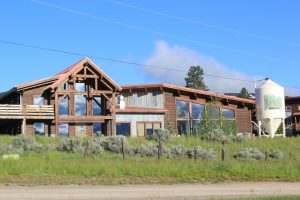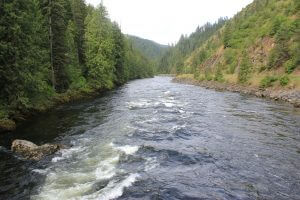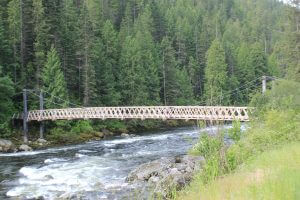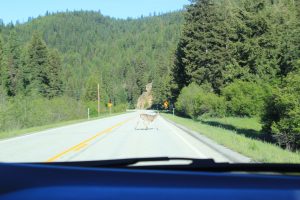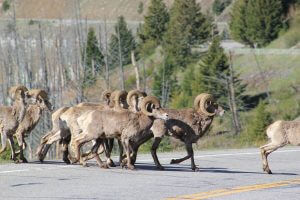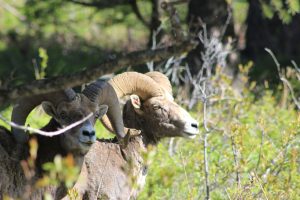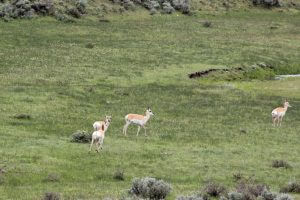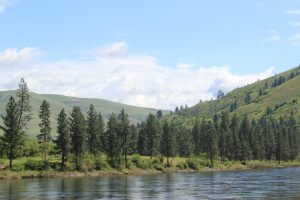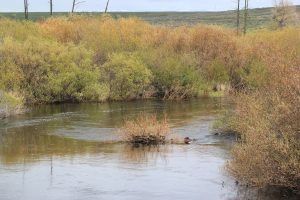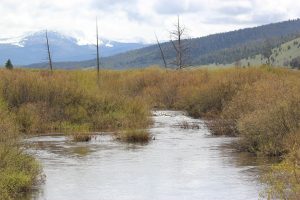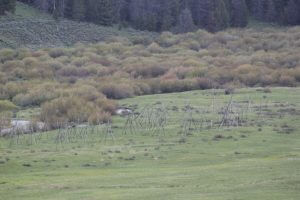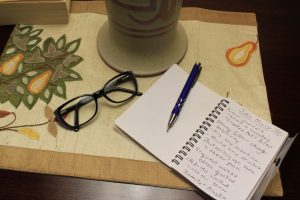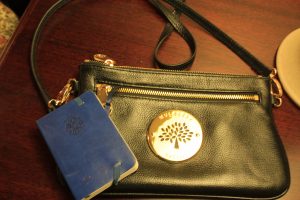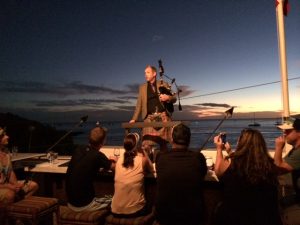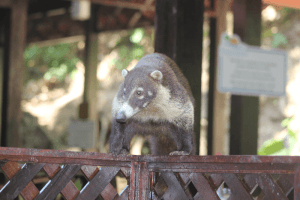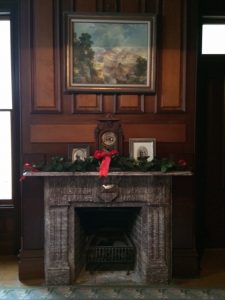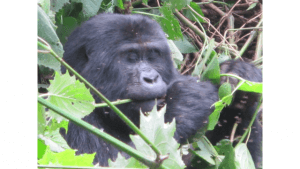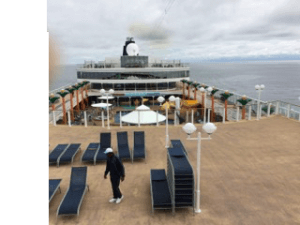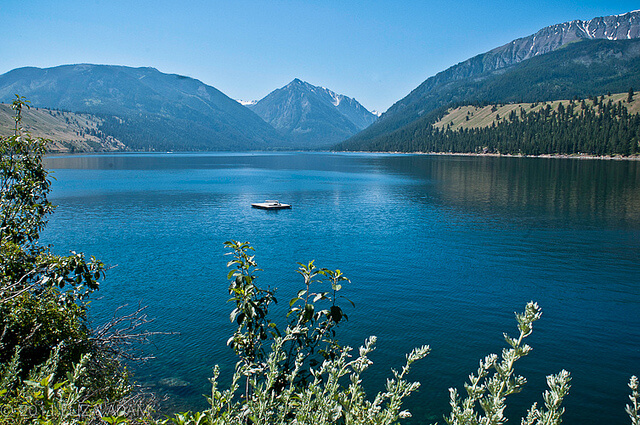
WHY YOU SHOULD TRAVEL THE BACK ROADS
It’s a straight shot from Yellowstone to Seattle once you hit I 90, but only take that route if you don’t like history and you don’t want to be inspired by the meeting of Lewis and Clark and the Nez Perce.
My husband and I exited I 90 at Butte, Montana, right where the Lewis and Clark Trail crosses the freeway. We drove southwest a bit and then northwest to Lolo, Montana with a stop at the Big Hole National Battle Field (see below).
Lolo Pass and the Nez Perce Trail
Lolo is a quaint little town near the Bitterroot Mountains, the perfect place to rest and dine at the Lolo Peak Brewery before an early morning start for Lolo Pass. Historic Highway 12 is the closest approximation of the original Nez Perce Trail (now unpaved Forest Road 500) and runs along the rough and shallow Lochsa River. Lewis and Clark’s Corps of Discovery used the Nez Perce Trail as a way west. Today Highway 12 gives you a feel for the topography they experienced and whitewater rafting if you’re around in May or June.
Before climbing into the Bitterroot Mountains, we saw plenty of game on the road.
But higher up, nothing. Which explained the dire conditions encountered by the Expedition on its eleven-day crossing of Lolo Pass. In 1805, September grew cold and snowy fast. The Bitterroot Mountains were bitter that year. With slow progress and no food sources, both men and horses grew weak, necessitating the consumption of three colts.
“We have always been here.” Nez Perce
When the Expedition descended into the valley at the Weippe Prairie, they met the Nez Perce, whose original name was not about pierced noses but about being “the real people,” the Nimiipuu.
The tribe welcomed the starving band with dried buffalo, bread, and fish. They rested among “original people” until they gained strength and learned how to burn a log into a canoe. With the help of Sacajawea, they developed so much trust that they left their horses with the tribe for safe-keeping and set off on the Clearwater River in dugout (burned out?) canoes.
In May, 1806, they collected their horses, rested again with the Nez Perce for over a month, and shared their technology—magnets, spyglasses, watches, and air guns. They left grateful and promised a “productive relationship” with the U.S. Government.
The Plus and Minus of the Lewis and Clark Expedition
Here on the Clearwater River is where the story turns dark, where erosion begins, not of land but of values. After cruising the hopeful, heroic path of the Corps of Discovery, we were suddenly confronted by the sad, life-or-death exodus of the Nez Perce from their homeland of thousands of years.
Several members of the Corps of Discovery kept excellent travel journals, and their publication caused a migration to the Northwest. First came the missionaries, then the fur trappers, farmers, gold miners, and problems. To avoid conflict the peaceful Nez Perce supported the treaty of 1855, which designated all of their land as a reservation. When gold was discovered on their property, a new treaty in 1863 reduced their land to one-tenth its original area.
Why did you kill us?
Many Nez Perce, including Chief Joseph and Chief Looking Glass, did not sign the 1863 treaty and refused to leave their land. When the government dispatched General Oliver Howard to force them onto an Idaho reservation, some overzealous young men killed four white people, and everyone had to flee. Once during a Nez Perce rest stop, soldiers hid in the reeds along the Big Hole River and launched a surprise attack at sunrise.
Technically, the tribe won this battle by capturing the military’s howitzer, injuring the commanding officer, and escaping. Yet, losing 60 to 90 people, most of them women and children, did not feel like a victory.
Today the National Park Service commemorates the battle with a haunting scene: a village of bare teepee poles. The scene is worth the hike to the river.
“My heart is sick and sad … I will fight no more forever.” Chief Joseph
After dragging the ailing and injured as far north as Bear Paw in Montana, the valiant Chief Joseph, surrendered, not because of defeat but because of exhaustion. Though he admired the chief greatly, General William T. Sherman put him on a train heading toward eight months in Leavenworth Prison and then seven years on a barren reservation in Oklahoma. He was finally permitted to return to the Northwest, where he died, his doctor said, “of a broken heart.”
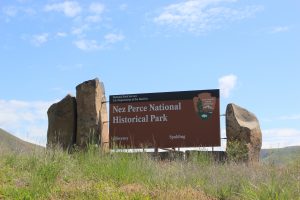 At the west end of the Nez Perce Trail is the Nez Perce historical site in Spalding, Idaho. Here the history is presented in a beautiful video and an interesting shop. You’ll meet Nez Perce people, who answer questions, point out the birds nesting by the visitor center, and explain the tribe’s current efforts to reintroduce the California condor, which lived in Hell’s Canyon until the mid-1800’s.
At the west end of the Nez Perce Trail is the Nez Perce historical site in Spalding, Idaho. Here the history is presented in a beautiful video and an interesting shop. You’ll meet Nez Perce people, who answer questions, point out the birds nesting by the visitor center, and explain the tribe’s current efforts to reintroduce the California condor, which lived in Hell’s Canyon until the mid-1800’s.
The National Park Service has published an Auto Tour Guide of some 1500 miles and 38 historical sites on the Nez Perce Trail. The information is available to you. So get off the freeway and find that empty road full of history.
Your comments are welcomed below.
Featured Image, Wallowa Lake by Eliza Addams, from Flickr in Creative Commons.
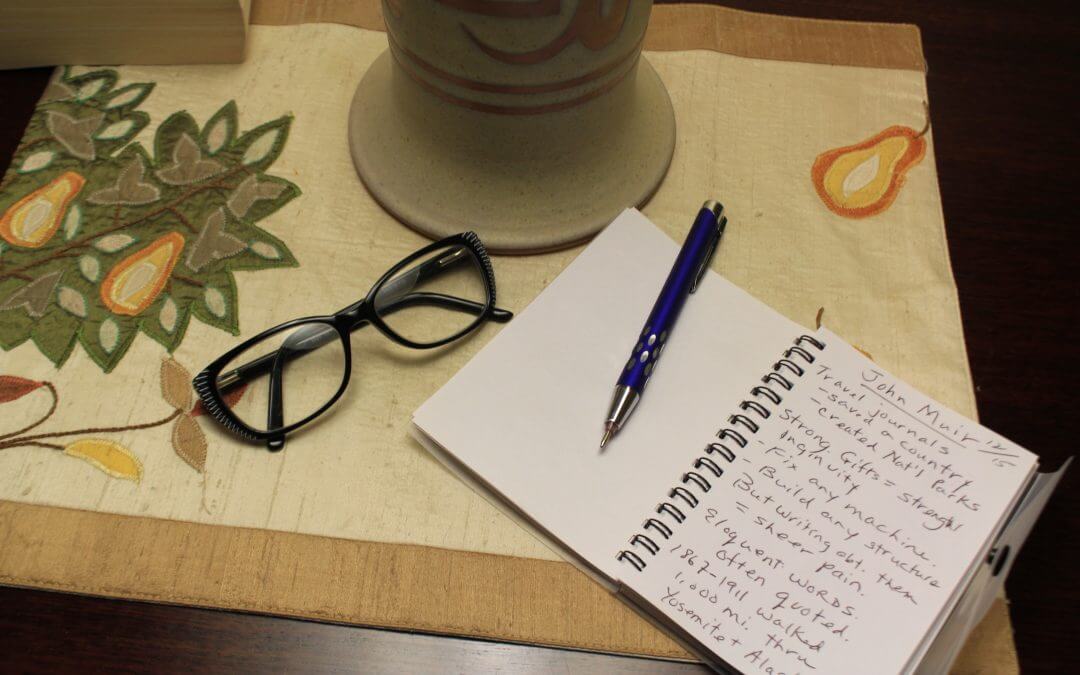
WHY EVERY TRAVELER NEEDS A WRITER’S NOTEBOOK
Every traveler, writer or not, should carry a writer’s notebook. You never know when someone will ask for travel advice, and you’ll want to be specific. You never know when you might write about it. Most of us don’t have the foresight of Hemingway, who began his notebook habit at age eight when the sage in his head told him: you are destined to travel and write. Most of us just never know what opportunities lie down the road.
A writer’s notebook jogs your memory.
If you start to write, you’ll quickly realize that the neither the details nor the topics arrive when you need them, like when you’re perched at your computer, fingers arced in ready position over the keyboard. No. They sneak up when you’re not looking. When you’re driving somewhere, watching TV, reading, or even, for me, when asleep. So if our house goes bump in the night, nope, it’s not that. It’s a big idea gently delivered on the wings of darkness and me, scrambling around to capture its essence before it drifts away as easily as it came.
That’s why my nightstand holds a writer’s notebook and a pen with a lighted ballpoint, the perfect Christmas gift from my writerly friend, Jes.
And so does my purse. My notebook follows me everywhere. It’s not a journal, mind you. It’s small and portable, just right for lists of words, or dates, or topics. While traveling, I listen for locations that I might want to write about. I also collect names of towns to use for settings and characters in future novels. The protagonist in my current project, Hamilton Lange, got his name while I was driving through Canada.
When you’re walking through a town or park you want to write about, it’s important to record not only what a place looks like—colors, sizes, numbers, composition—but how it feels to you, the temperature, the smells, the sounds,the roughness of the terrain, the mood it creates. Like on this beautiful balmy night on Maui.
In Hawaii one expects ukelele music, so it’s quite a delightful surprise —especially for we Scots —to hear a Scotsman pipe down the pink sun on the rooftop of Mick Fleetwood’s restaurant in Lahaina (while still savoring the oysters and Chardonnay from the dollar-per-oyster happy hour.)
It’s also important to record your photos.
 How many times I have a taken a picture of a beautiful flower like this (could it be some kind of trumpet?),
How many times I have a taken a picture of a beautiful flower like this (could it be some kind of trumpet?),
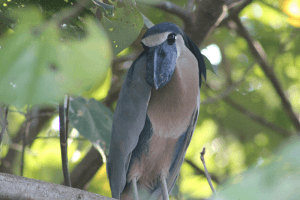 or of a rare bird like this ( could it be some kind of heron?),
or of a rare bird like this ( could it be some kind of heron?),
or an animal like this (could it be a coati?) and then forgotten its precise name? The moral of the story is even if you go on a boat trip (this one was in Costa Rica), if you can’t carry a writer’s notebook, take notes as soon as you return to dry land.
A writer’s notebook is just as handy for non-writers. You never know…
Many famous writers started out as just curious people with pens and pads.
John Muir loved hiking and nature. The week after he quit his factory job, he walked from Indiana to Florida, jotting down fascinating details along the way. And the more he jotted, the more fascinated he became. While living in Yosemite, he described seasons, drew plants, and recorded glacier theories.
He never dreamed he’d end up writing travel stories for the newspaper and persuasive letters to Congress. He’d always hated to write. Writing, he said, was like “the life of a glacier; one eternal grind.” Having detailed notebooks saved him a lot of grief.
Muri did his formal writing at his home outside San Francisco. He’d scatter his notebooks, drawings, and drafts across the living room floor and nervously pace around them until he collected the best words and phrases.
Young Samuel Clemens started the notebook habit when he could not remember all of the instructions in training to be a steamboat pilot on the Mississippi. His notations evolved into masterpieces of literature. And I’ll bet a note or two included a mark and a twain.
George Lucas, also, noted words that became names. In an early job of mixing movie sound, he had to keep asking for Reel 2 Dialogue 2. He loved the ring of it and wrote it down: R2D2.
I didn’t know what the future held either.
Years ago, I had no inkling I would ever write travel stories about distant lands or thrillers about dictators. But my old notebooks foreshadow as much. They reveal my surprise at how quickly the U.S. changed allegiance from the party boy, Ferdinand Marcos to the serious Corazon Aquino. My anger at the greedy Mobutu for passing unfair laws in the Congo, which required expats, like me, to pay expenses that were the really the government’s responsibility. My fear of being surrounded in the middle of the night by a crazed religious cult along the Congo River.
And yet my joy at communing with the gentle mountain gorillas in that very same country. NB: Real gorillas are really much sweeter than the ones in the latest Tarzan movie.
It’s so beneficial to have a record of what the life and scenery were like at a particular time and place, and, more importantly, how it made you feel, which is what your readers and your friends really want to know.
A writer’s notebook is priceless. Invest yourself on its pages today.

Alaska: It’s Still Wonderfully Wild Out West
When most people go on vacation, they head south for warm temperatures and sunny skies. But last week guest blogger Dave Hermetet wanted some different scenery, so he and wife, Sarah, headed north to Seattle for a seven-day cruise to Alaska. See what Dave has to say about it.
Need a break from the summer heat? Join an Alaska cruise.
 The Norwegian Jewel, small as cruise ships go, sails out of downtown Seattle on Saturdays at about 5:00pm. While cruising, we enjoyed the deck activities.
The Norwegian Jewel, small as cruise ships go, sails out of downtown Seattle on Saturdays at about 5:00pm. While cruising, we enjoyed the deck activities.
By night we took in the performances and motivational speakers on board. By day we toured the rugged natural wonders of Alaska and Canada. Our itinerary included Ketchikan, Juneau, Skagway, and Victoria, B.C., each one unique in its own way.
Ketchikan offers the perfect introduction to Alaska.
We spent all of Sunday at sea, heading north to Ketchikan, the “salmon capital of the world.” And, yes, the title is accurate. You can actually walk down to the end of Creek St. and watch the salmon struggle up the stream which runs down to the harbor. Your heart breaks when you see how hard they work and how often they fail to make the jump.
Norwegian offers a large number of shore excursions. Whale watching was one of the most popular activities in Ketchikan.
 We took the option to board the powerful inflatable boats to speed out to the Tongass National Forest, the largest rain forest in North America. And we got much more than we bargained for.
We took the option to board the powerful inflatable boats to speed out to the Tongass National Forest, the largest rain forest in North America. And we got much more than we bargained for.
 At Tongass we found an archipelago, encompassing islands, fjords, glaciers, and mountains, our first glimpse into wild Alaska.
At Tongass we found an archipelago, encompassing islands, fjords, glaciers, and mountains, our first glimpse into wild Alaska.
 After-hike snacks included freshly smoked wild salmon.
After-hike snacks included freshly smoked wild salmon.
While sailing back to the marina, we lucked out. Seeing one whale is thrilling enough, but seeing a whole pod of humpbacks breach the surface, dive back down, and flip their tales at you is amazing.
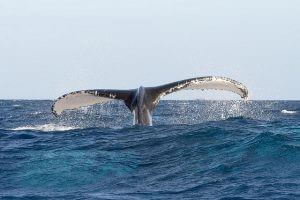
Humpback whales, Christopher Michael
They were bubble feeding. It’s a unique humpback fishing technique, where a group of whales creates a circle of bubbles as they swim around a school of fish. As the bubbles move closer together, the trapped fish are forced inward and upward for easier feeding.
Juneau, Alaska is the only US capital not accessible by road.
Our next port of call was Juneau, named after gold miner, Joe Juneau. Since the rugged mountains cut it off from all road travel, the harbor is filled with boats and sea planes.
 The Mt. Roberts Tramway, run by the indigenous Tlingit people, took us 1,800 feet up to the visitor’s center. A clear day offers a spectacular view of Juneau and the Gastineau Channel.
The Mt. Roberts Tramway, run by the indigenous Tlingit people, took us 1,800 feet up to the visitor’s center. A clear day offers a spectacular view of Juneau and the Gastineau Channel.
Hikers can choose from a series of trails all over the mountain top. Some take 90 minutes, and others take several hours. You can also visit the Juneau Raptor Center, which rehabilitates injured raptors like this eagle.
And now, the glacier, the main reason for any Alaska cruise.
From Juneau, the ship sailed to the Sawyer Glacier. Smaller ships are allowed to sail up a stunning, narrow fjord, the Tracy Arm passage, with sheer rock walls and beautiful waterfalls.
We approached to within 1/2 mile of the base of a deep blue glacier just as it broke off and splashed into the ocean.
 The cruise lines are dedicated to protecting and respecting Alaskan wildlife. This is as close as ships go in June because of cute little seal pups nestling on the ice floes. The ship spun in a slow circle so everyone on board got a good view of the glacier and the incredible blue ice.
The cruise lines are dedicated to protecting and respecting Alaskan wildlife. This is as close as ships go in June because of cute little seal pups nestling on the ice floes. The ship spun in a slow circle so everyone on board got a good view of the glacier and the incredible blue ice.
Skagway was a nearly defunct gold-rush port until revived by the Alaska tour industry.
After steaming north, we arrived at Skagway, a small wild west town of board sidewalks and colorful gold rush history. Its most famous establishments were the many brothels, like the notorious Red Onion, which “mined the miners.” Several ladies still work upstairs, but only as museum interpreters.
The original gold rush routes of the late 1890s went from one of two places, Skagway through the White Pass or from the now-abandoned town of Dyea and over the Chilkoot Trail. Many cruise line excursions take the narrow gage railroad up to the White Pass for a glacier hike. Others take a bus tour paralleling the railroad and going on through British Columbia to Carcross into the Yukon.
In Emerald Lake, the light green water is knee deep, and the dark blue water is 200 feet deep.
It’s obvious why so many people retire in Victoria.
On Friday our ship arrived in Victoria, BC, where we enjoyed the “banana climate” that attracts retirees from around the world. While it was sixty degrees in Seattle across Puget Sound, it was eighty in Victoria, a pleasant climate for touring the very-British provincial capital of British Columbia.
The best part of Vancouver Island is the spectacular Butchart Gardens.
 In the early 1900s, Jenny Butchart converted the family’s ugly and spent limestone quarry into one of the most beautiful gardens in North America.
In the early 1900s, Jenny Butchart converted the family’s ugly and spent limestone quarry into one of the most beautiful gardens in North America.

Strolling among the lush greenery and red roses was a spectacular way to end an amazing vacation.
Tips for taking a cruise to Alaska:
Bring warm clothes that can be worn in layers including gloves and a warm hat.
Bring good hiking boots/shoes if you plan to do much hiking.
Bring Bug spray because the mosquitoes are huge.
Bring you binoculars and cameras. There are so many things to see from majestic eagles to whales.
Canadians seem to be glad to accept US dollars so there is no need to get Canadian currency.

